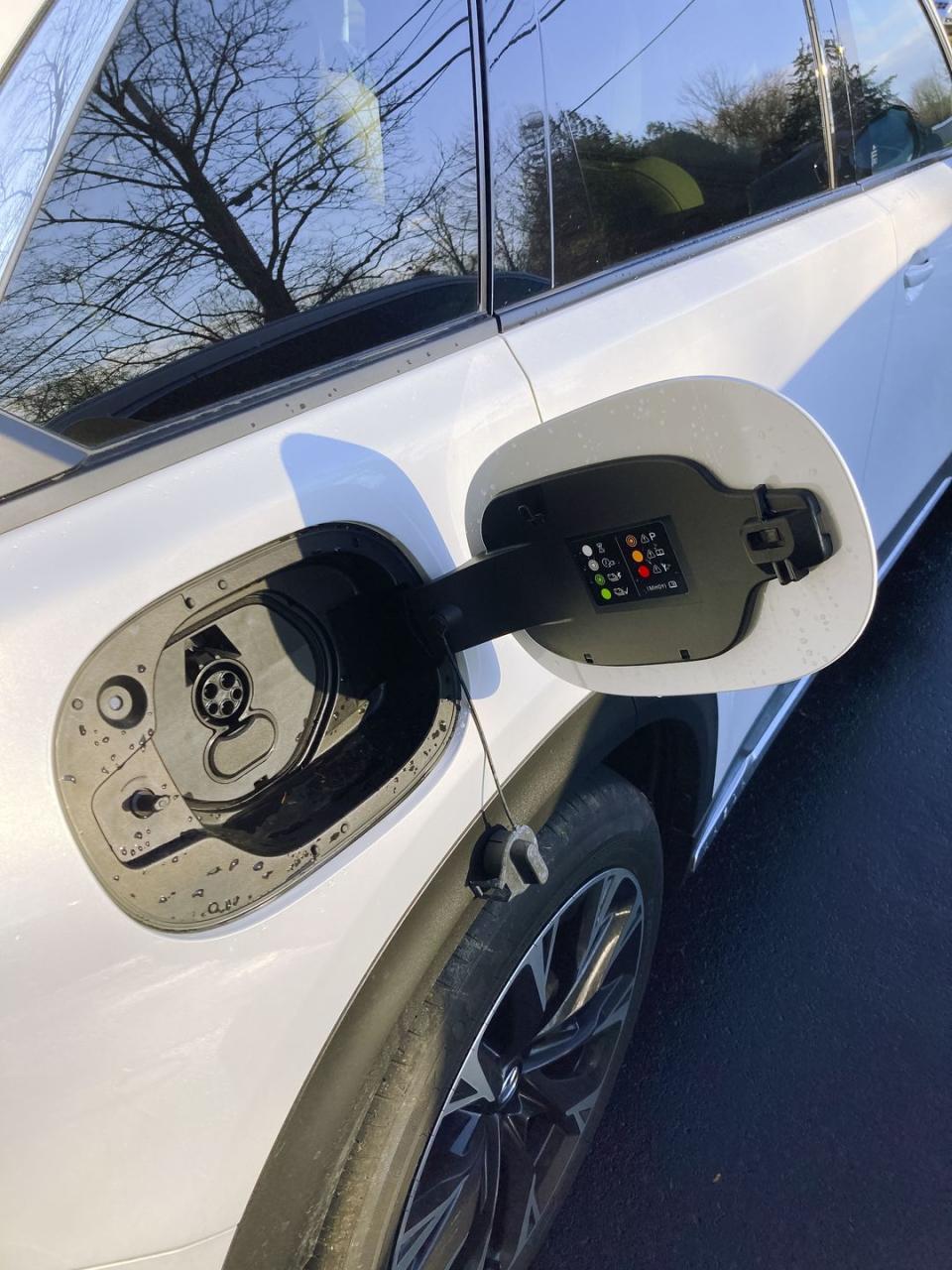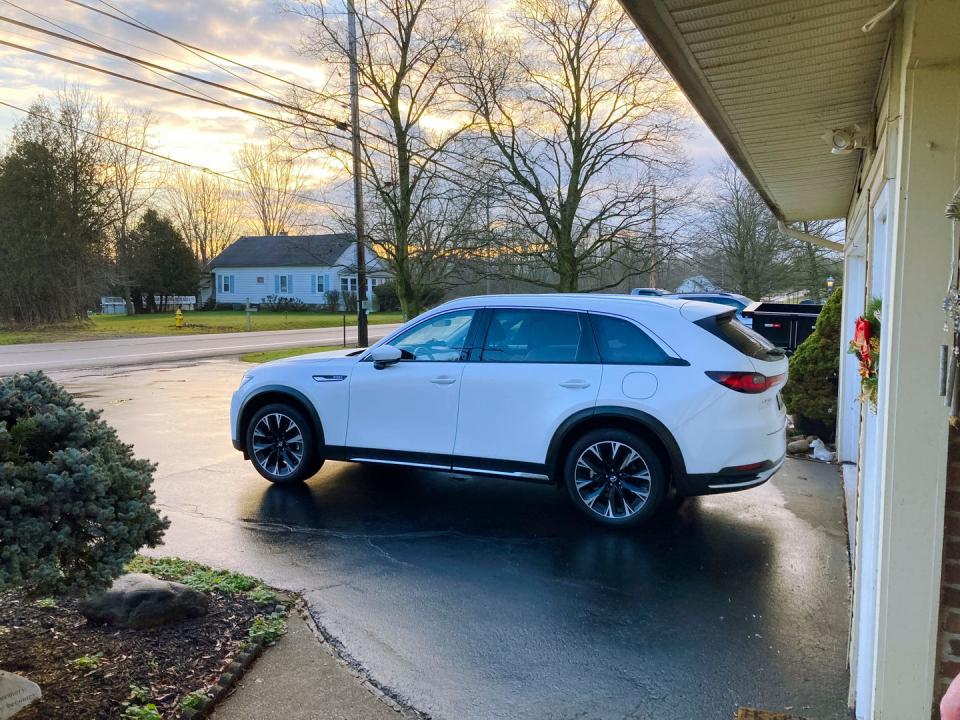Can Plug-In Hybrids Fix Every Car?

There's lots of love for plug-in hybrids at Road & Track. We love them as ultra-efficient cars, like the Prius, and as high-performance sports cars, like the Ferrari 296GTB. On one end, you get great economy. On the other, great power. What can't a plug-in-hybrid system do? Could it cure maybe even the most disadvantaged car? What if your first gallon of gas, even in a three-row crossover, were free?
In a moment when EVs from both startups and mainstream automakers are chasing as much range as possible—250 miles is the standard, 300 plus is when things start to get interesting, 400-odd makes the news—the Mazda CX-90 PHEV's all-electric range is a throwback. Maybe that's refreshing. You do not get a big battery at all. It's a mere 17.8 kWh. That's an infinitesimal fraction the size of, say, the "Max" 149-kWh pack in the Rivian R1S. While that Rivian (a vehicle that's just about the same size as the Mazda, if taller and a bit wider) is EPA-estimated at going 400 miles on a charge; the Mazda CX-90 PHEV gets rated at 25. Unless I were driving carefully, it would start wheezing not long after 20.

Remember that this is not a minute vehicle. It was hard to forget while driving it. Every time I turned to reverse, the Mazda seemed to stretch endlessly behind me. Parked at the local public charger, it extended past the parking lines. This is a seven- or eight-seater car, depending on how you spec it. Per Mazda, it'll tow 3500 pounds. It makes 323 hp on premium, 369 lb-ft of torque—both factoring in the 68-kW electric motor—and weighs a hulking 5236 lbs on our sibling publication Car and Driver's scales. Since it's a Mazda, you do get double-wishbone suspension up front and a multilink setup in the back. The ride is nice. The interior is nice. The visibility is good for this kind of thing, and it starts at just over $51,000. It's a domestic bus for the suburban set.

What's fascinating is that with the battery depleted, the Mazda CX-90 PHEV will still turn around only about 24 mpg. The whole six-hour highway drive up to the wintery Finger Lakes here in New York grumbled the car right down to that figure, the battery depleting itself not long after I left the city. What once was 40 became 30. What once was 30 became 24.5. It's about the same as the nonhybrid CX-90 at that point. That is to say, plug in your PHEV CX-90, and it's as if your first gallon's worth of gas were free. Like it never happened. Like you downloaded your first gallon of gas from BitTorrent.
But would that be enough to make a real dent in the economy of the CX-90? I had a week of classic mixed-use driving ahead of me, running errands before Christmas, DD'ing various relatives around from party to party, and so on. I was staying on the edge of one town, often visiting another, and had a few public chargers along my regular routes.

It was with great dismay that, after spending nearly 20 minutes of my life navigating the living hell that is a shopping-mall parking lot during the holidays, I remembered this CX-90 is not compatible with Level 3 charging. Level 1 charging is plugging into a regular wall outlet of 120 volts. Level 2 is either plugging in to a 240-volt outlet at home, or a slow (typically 208-volt) public charger. The CX-90 will go from empty to full essentially overnight on the former, and in a few hours on the latter. A Level 2 charger will recoup most of your range home during the time it takes for you to do your shopping. The CX-90 PHEV doesn't really need Level 3 charging. But it'd have been nice! After my 20-mile drive to pick up a last-minute gift card, I was looking forward to a free 20 miles back and instead had to listen as the healthy turbo 2.5-liter four kicked into life ahead of me. I was rather pleased to have that same engine at my disposal when I was driving the not-quite-a-Mazdaspeed 3, doing some big AWD donuts in a snowy parking lot. In this CX-90, it was an admission of defeat. Poor planning. I watched as the MPG counter ticked down with every passing mile.
Baselining at 24 mpg is a deep hole to climb out of.

Over the course of my week, I was able to keep much of my mileage within my EV-only range. The rest was gas, and my final fuel economy before the long highway drive home was a proud 44. A couple hundred miles of over-the-Catskills highway tumbled that down to 30 when I made it to my Brooklyn neighborhood.

All said and done, I was remarkably impressed with the CX-90. If I did find myself abandoning the city and relocating to a village or the 'burbs, somewhere I would properly need a car, most of my driving would be like it was in that week. And most of that driving fell within my 20-odd miles of range. Had I spent another week in the Finger Lakes, my MPG would have only climbed. With every week longer, up and up it'd go.
I still remember the summer of 2008. I was interning at the Plug-In Hybrid and Electric Vehicle Research Center, an office within the University of California, Davis's Institute of Transportation Studies. (We often make fun of long car name acronyms, but nothing is quite as bad as saying you're with the UCD ITS PHEV research center.) The second-gen Prius was still new on showroom floors, and the prospect of a plug-in model was far on the distant horizon. If you wanted a PHEV Prius, you were towing a trailer of extra batteries behind you. I met those guys. I remember all of those early adopters at various conferences and meetings those sunny months home in California, just as I remember boring various Tesla engineers at a company picnic about what I thought the still-unseen Model S should look like. I remember asking my boss if he thought the first-gen Chevrolet Volt would be a good car. He laughed, "If they can ever build the thing."
The Volt turned out to be something of a confused car. GM struggled to explain how it was different from other hybrids, or what was so clever about its engineering. Only owners, like our own editor-at-large Matt Farah, discovered that in day-to-day driving, the gas engine rarely kicked in at all. As long as you keep the thing charged, you have a car that runs on electricity.
I can't tell you how far away a car like the Mazda CX-90 PHEV seemed back in those days. Before even the Volt had come out. It's a completely ordinary car, one that is big and roomy and makes no extraordinary compromises toward efficiency, and yet with even a tiny plug-in-hybrid system, it has the ability to drive as economically as the most lightweight, aerodynamic supercommuter. Remember that this was an age of people spending thousands upon thousands on used Geo Metros. I remember kids driving to high school in GEM EVs, those extra-large roadgoing golf carts. Imagining a leather-lined crossover silently cruising into the parking lot at the same time was not quite science fiction but not far off.

Time will come to make the CX-90 PHEV obsolete too. Maybe solid-state battery tech will make all crossovers like it easily all-electric. Or maybe we'll make all SUVs illegal and we'll commute on trains and streetcars like we used to. But for now, in this moment, I am stunned at how much a car like this can accomplish.
You Might Also Like

 Yahoo Finance
Yahoo Finance 